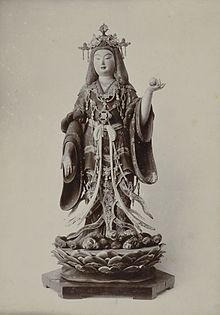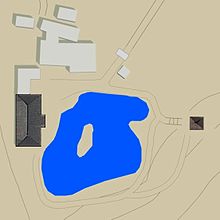Jōruri-ji
The Jōruri-ji ( Japanese 浄 瑠 璃 寺 ) is a Buddhist temple in a remote, mountainous forest area on the outskirts of today's city of Kizugawa , Kyoto Prefecture . It is also called Kuhon-ji or Kutai-ji. The temple belongs to the Risshū branch of Shingon-shū .
history
According to the "History of the Jōruri-ji Temple" ( 浄 瑠 璃 寺 流 紀事 , Jōruriji ryūkiji ) the temple was laid out in 1047 by the monk Gimyō ( 義 明 ) from Taima-dera as a covered pavilion ( 堂 宇 , dōu ). First, the Healing Buddha ( 薬 師 如 来 , Yakushi nyorai ) was worshiped. In 1107 a new main hall was built in which nine Amida Buddhas (Kutai Amida nyorai) were placed side by side. In 1150, priest Izu Sojō Eshin ( 伊豆 僧 正 恵 信 ) from Kōfuku-ji laid out the pond and garden and thus created the basis for the current temple complex. In 1178 the bell tower was completed. In the same year Ichijō Ōmiya in Kyōto (Kamikyo-ku district) moved the three-story pagoda here.
From the late Heian period to the Kamakura period , the other buildings, the dining hall, the kitchen building and a prayer hall were built, with ceremonies ( 法 会 , Hōe ) being carried out upon completion . Relations with the Kofuku-ji continued to develop and remained close. Later, however, the temple broke away from the Kōfuku-ji and today belongs to the Risshū ( 律宗 ) direction of Buddhism.
In 1343, the teaching hall and other buildings were lost in a fire, the main hall and the pagoda were fortunately spared. During the overhaul of the main hall in 1666, the roof, which had previously been covered with cedar shingles, was now covered with tiles. In 1900 the main hall and the pagoda were dismantled and reassembled after necessary repairs.
In the following, the symbols common in Japan are marked with ⦿ as national treasures and as important cultural property of Japan .
The attachment
The facility is laid out around a pond: the main hall, which is laid out in north-south direction, is on the other side of the pond in the east on a slight hill opposite the pagoda.
The main hall ( 本 堂 , hondō ; ⦿) from the year 1107 shows a row of 12 columns on its front side, 5 columns follow one another in the depth. What is unique is that the complete set of 9 Buddhas has been preserved side by side inside.
The three-story pagoda ( 三重 塔 , sanjū-no-tō ; ⦿) from 1178 is not particularly large with a height of 16.5 m, but shows the elegance of the late Heian period .
Temple treasures
- In the main hall you can see:
Nine Amida Buddhas ( 阿 弥陀 如 来 坐像 , Amida Nyorai zazō ; ⦿) sitting, made of lacquered wood. The central Buddha is 222 cm high and shows the Raigo Mudra , the companions are between 138 and 143 cm high and show a Dhyana (Samahita) Mudra
The four kings of the sky , ⦿, are made of painted wood. Jikokuten is 169.5 cm high, Zōjōten is 169.0 cm high, Kōmokuten is 168.3 cm high, and Tamonten is 166.5 cm high. (The latter two are in the care of the Kyōto National Museum ). They protect the Buddhas in the four directions. Set up in the four corners of the temple, they are in the order given in the northeast instead of the east, and accordingly in the southeast, southwest and northwest.
Kichijō-ten in the cabinet (厨子 入 木造 吉祥 天 立 像 , Zushiire mokuzō Kichijōten ritsuzō ; ◎), the sky goddess for well-being, fertility and beauty, here a standing figure made of painted wood and 90 cm high, is dated to the year 1212.
Horsehead Kannon ( 馬頭 観 音 立 像 , Batō Kannon bosatsu ritsuzō ; ◎), a standing figure made of painted wood and 106.5 cm high, is dated to the year 1241. The name of this type comes from the strict, male face that distinguishes it from the otherwise female Kannon.
Jizō bosatsu (地 蔵 菩薩 立 像 , Jizō bosatsu ritsuzō ; ◎), a standing figure made of painted wood and 157 cm high, dated to the year 1241.
Fudō myōo (不 動 明王 ; ◎), one of the Shining Kings, recognizable by the sword and the chain.
Two stone lanterns ( 燈籠 , Dōrō ; ◎) in front of the main hall.
- In the pagoda you can see:
A seated Yakushi Nyorai ( 木造 薬 師 如 来 坐像 ; ◎) 85.7 cm, made of wood from the Heian period. He was the original main cult figure and is only open to the public on the 8th of each month, at the beginning of spring and autumn and on three days at the New Year.
Wall painting from the Heian period on the ground floor.
Remarks
- ↑ Kuhon ( 九品 ) or Kutai ( 九 体 ) means "nine figures".
- ↑ The right hand is raised and shows the inner surface of the hand, the left hand rests on the left knee and is open upwards in a giving form.
- ↑ A Dhyana (Samahita) mudra is characterized by hands placed on the knees with thumbs and fingertips touching each other.
Individual evidence
- ↑ Mainichi Shimbun-sha (ed.): Juyo bunkazai 12. Kenzobutsu I. Mainichi Shimbun-sha, 1973. p. 109.
- ↑ a b Suzuki, Toshihiko (ed.): Jōruri-ji . In: Nihon daihyakka zensho (Denshibukku-han) ”, Shogakukan, 1996.
- ↑ a b c d e f Hamashima, Masaji. Joruri-ji . In: Joruri-ji, Gansen-ji, Kaijusen-ji. Yamato no furudera 7. Iwanami Shoten, 1981.
- ↑ a b Kyoto-fu rekishi isan kenkyukai (ed.): Joruri-ji . In: Kyoto-fu no rekishi sampo (ge). Yamakawa Shuppan, 2011. ISBN 978-4-634-2 4826-7 .
literature
- Sakai, Naoyuki (Ed.): Nihon no jiin. Rekishi no naka no shukyo. Shinjinbutsu-ofuku-sha, 2003.
Web links
Coordinates: 34 ° 42 ′ 56 ″ N , 135 ° 52 ′ 22 ″ E





